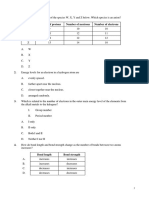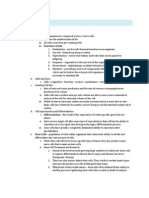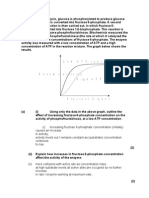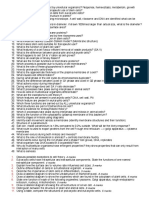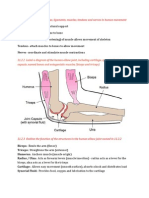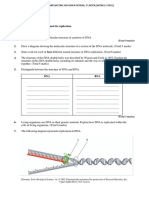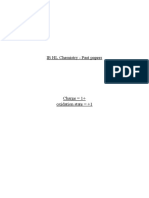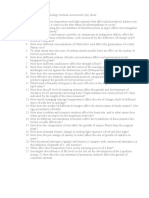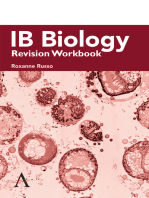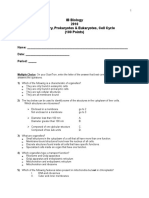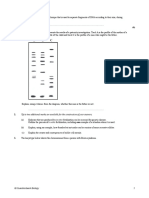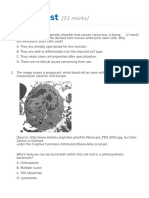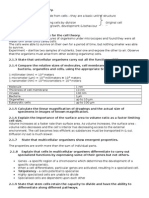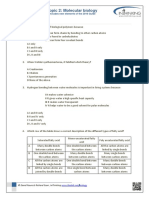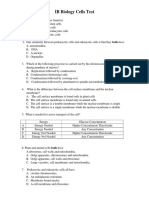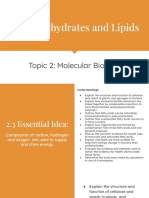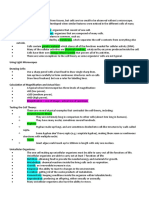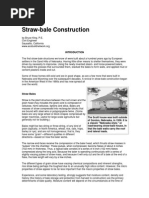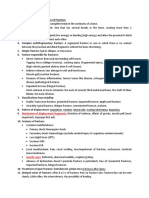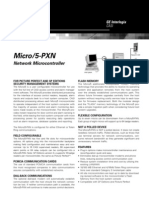IB HL Biology Photosynthesis Notes
IB HL Biology Photosynthesis Notes
Uploaded by
Tiffani ChoyCopyright:
Available Formats
IB HL Biology Photosynthesis Notes
IB HL Biology Photosynthesis Notes
Uploaded by
Tiffani ChoyCopyright
Available Formats
Share this document
Did you find this document useful?
Is this content inappropriate?
Copyright:
Available Formats
IB HL Biology Photosynthesis Notes
IB HL Biology Photosynthesis Notes
Uploaded by
Tiffani ChoyCopyright:
Available Formats
PHOTOSYNTHESIS
I. Photosynthesis in General a. Autotrophs use photosynthesis to produce organic compounds form carbon dioxide and water. The oxygen and glucose produced are then used by cells in cellular respiration, where carbon dioxide and water are produced. b. Products of photosynthesis are reactants of cellular respiration. Products of cellular respiration or reactants of photosynthesis c. Involves two Stages i. Light reaction light energy from the sun is converted into chemical energy, which is temporarily stored in ATP and NADPH, which is the energy carrier molecule ii. Calvin Cycle organic compounds are formed using CO2 and the chemical energies stored in ATP and NADPH d. 6CO2 + 6H2O + light energy C6H12O2 + 6O2 The Light Reactions (requires light) a. Light and Pigments i. White light can be separated into its component colors by passing it through a prism, the resulting colors range from red to violet, and is known as the visible spectrum ii. Each color has a different wavelength, measured in nanometers. iii. When white light strikes an object, its component colors can be reflected, transmitted or absorbed by the object. iv. Pigments compounds that absorb light v. The absorbed colors are removed from the visible spectrum, so the light that is reflected or transmitted back by the pigment no longer appear white b. Converting Light Energy to Chemical Energy i. General Overview 1. Pigments in chloroplast capture light energy, which is converted into chemical energy and temporarily stored as ATP and NADPH. Oxygen is given off as a byproduct 2. Chlorophylls and carotenoids are clustered in in groups of a few hundred pigment molecules in the thylakoid membrane. Group of pigment molecules and the proteins they are embedded in are called a photosystem. There are two type of photosystem I and photosystem II. 3. Light reaction begins when accessory pigment molecules in both photosystems absorb light. When doing so, they acquire some of the energy carried by the light. In each photosystem, this energy is passed on to other pigment molecules until it reaches a specific pair of chlorophyll a molecules which can also absorb light ii. Steps 1. Light energy forces electrons to enter a higher energy level in chlorophyll a molecules of photosystem II. They are in an excited state and have enough energy in order to leave the chlorophyll a molecules 2. Primary electron acceptor, a molecule in the thylakoid that the electrons enter 3. Primary electron acceptor donates the electron to a series of molecules which transfer electrons from one molecule to the next, known as electron
II.
transport chain. As electros move from molecule to molecule in the chain, original energy is lost, which is used to move H+ protons in the thylakoid. 4. Light is absorbed by photosystem I at the same time that light was absorbed by photosystem II. The electrons from the chlorophyll a molecules are moved to another primary electron acceptor. The electrons lost by these chlorophyll a molecules are replaced by the electrons that passed through the electron transport chain from photosystem II. 5. Electrons in photosystem I is excited by light energy and enters another electron transport chain, which brings them to the other side of the thylakoid membrane. Electrons combine with a proton and NADP+, an organic molecule that accepts electrons during redox reactions, and causes NADP to be reduced to NADPH. iii. Replacing Electrons in Light Reactions 1. Electron from chlorophyll molecules in photosystem II replace the electrons that leave chlorophyll molecules in photosystem I. Replacement electrons are produced by water molecules. Enzyme inside the thylakoid splits water molecules into protons, electrons, and oxygen. 2. 2H2O 4H+ + 4e- + O2 3. For every two molecules of water split, four electrons become available to replace those lost by the chlorophyll molecules in photosystem II. The protons produced are left inside the thylakoid, and oxygen diffuses out of chloroplast to leave the plant. iv. Making ATP in Light Reactions 1. Chemiosmosis process during light reactions in which ATP is synthesized, and relies on a concentrated gradient of protons across the thylakoid membrane. 2. Protons are produced by slitting of water molecules or pumped from the stroma to the interior of the thylakoid. Energy required to pump these protons are supplied by excited electrons. Concentration of protons is higher inside the thylakoid than in the stroma 3. Concentration gradient represents potential energy, harvested by enzyme ATP synthase in thylakoid membrane. It makes ATP by adding a phosphate group to ADP. ATP synthase converts the potential energy of the proton concentration gradient into chemical energy stored in ATP
III.
The Calvin Cycle series of enzyme-assisted chemical reactions that produces a 3-carbon sugar a. Carbon Fixation i. Carbon atoms form carbon dioxide in the atmosphere is fixed onto organic compounds. ii. 3 molecules of carbon dioxide must enter the Calvin cycle to produce each 3-carbon sugar b. Steps i. CO2 diffuses into the stroma from the surrounding cytosol, and enzyme combines each CO2 molecule with a 5-carbon molecule known as ribulose biphosphate (RuBP) and results in a very unstable six-carbon molecule that immediately splits into 2 3-carbon molecules, known as 3-phosphoglycerate (3-PGA) ii. Each 3-PGA receives a phosphate group from a molecule of ATP, then receives a proton from NADPH and releases a phosphate group. The ADP, NADP+, and phosphate that are produced can be used again in light reactions iii. One G3P molecules leaves the Calvin cycle and is used to make organic compounds in which energy is stored for later use iv. Remaining G3P are converted back into RuBP by adding phosphate group from ATP, and reenter Calvin cycle.
You might also like
- IB Chemistry HL Internal AssessmentDocument14 pagesIB Chemistry HL Internal AssessmentZinzan Gurney100% (2)
- Polymer Viscoelasticity: Stress and Strain in PracticeDocument900 pagesPolymer Viscoelasticity: Stress and Strain in Practicerin karin100% (1)
- IB Chem HL Atomic Structure QuestionsDocument5 pagesIB Chem HL Atomic Structure QuestionsKRISHANG MAHAJANNo ratings yet
- Sop of Tablet & CApsuleDocument2 pagesSop of Tablet & CApsuleZeyad A AbdullahNo ratings yet
- International Baccalaureate (IB) Database Questions Biology HLDocument20 pagesInternational Baccalaureate (IB) Database Questions Biology HLTonia von HugoNo ratings yet
- Carbohydrates & Lipids & Amino Acid - IB Style QNS: Written QuestionsDocument6 pagesCarbohydrates & Lipids & Amino Acid - IB Style QNS: Written QuestionsFariha Ayman Santi100% (1)
- IB HL Chemistry Atomic Structure QuestionsDocument20 pagesIB HL Chemistry Atomic Structure Questionshaseabamin100% (3)
- Previous IB Exam Essay QuestionsDocument58 pagesPrevious IB Exam Essay QuestionsDah Lin J92% (12)
- IB Biology Questions - Paper 1 Topic 6 QuestionsDocument36 pagesIB Biology Questions - Paper 1 Topic 6 QuestionsIB Blueprint95% (20)
- IB Biology Questions - Paper 1 Topics 1 + 2 QuestionsDocument28 pagesIB Biology Questions - Paper 1 Topics 1 + 2 QuestionsIB Blueprint79% (14)
- Topic 8 Ib Chem Questionbank 3Document8 pagesTopic 8 Ib Chem Questionbank 3IrawanQ-petNo ratings yet
- O Level Biology Practice Questions And Answers: Heredity And Molecular GeneticsFrom EverandO Level Biology Practice Questions And Answers: Heredity And Molecular GeneticsNo ratings yet
- O Level Biology Practice For Structured Questions Transport In HumansFrom EverandO Level Biology Practice For Structured Questions Transport In HumansNo ratings yet
- IB HL Biology Chapter 2 Notes CellsDocument5 pagesIB HL Biology Chapter 2 Notes CellsTiffani Choy100% (1)
- IB HL Chemistry GlossaryDocument18 pagesIB HL Chemistry Glossaryemily100% (1)
- Ib Chemistry BondingDocument18 pagesIb Chemistry BondingAaron Bonner100% (1)
- CHEMISTRY NOTES (Excl F) PDFDocument58 pagesCHEMISTRY NOTES (Excl F) PDFT-girlNo ratings yet
- Questions and Mark Scheme Enzymes 02 To 08 SL N HLDocument39 pagesQuestions and Mark Scheme Enzymes 02 To 08 SL N HLmedic8209100% (1)
- Ib Bio Previous IB Exam Essay QuestionsDocument34 pagesIb Bio Previous IB Exam Essay Questionssrahimi@verizon.net100% (3)
- Ib HL Chemistry 1 Midterm ReviewDocument15 pagesIb HL Chemistry 1 Midterm Reviewlngo_4No ratings yet
- Introduction To IB ChemistryDocument46 pagesIntroduction To IB ChemistryAnnika FeignNo ratings yet
- IB Biology Higher Level Human and Health Physiology NotesDocument41 pagesIB Biology Higher Level Human and Health Physiology NoteshunarsandhuNo ratings yet
- IB BIOLOGY TOPIC 1 QuestionsDocument3 pagesIB BIOLOGY TOPIC 1 QuestionsSarah Mason100% (1)
- HL IB BiologyDocument3 pagesHL IB Biologycoolcat132100% (2)
- IB Biology HL 2.7 WorksheetDocument9 pagesIB Biology HL 2.7 WorksheetKaze100% (1)
- IB Chemistry Topic1 - HLDocument4 pagesIB Chemistry Topic1 - HLChe Jen Wang100% (1)
- 2016 HL Bio Exam AnswersDocument3 pages2016 HL Bio Exam AnswersEricaNo ratings yet
- IB Chemistry SL Revision Option DDocument6 pagesIB Chemistry SL Revision Option DMinh MinhNo ratings yet
- IB Biology Plant ScienceDocument26 pagesIB Biology Plant Sciencealekzi67% (3)
- IB Biology HL 2.6 WorksheetDocument10 pagesIB Biology HL 2.6 WorksheetKazeNo ratings yet
- IB Chemistry Student HandbookDocument28 pagesIB Chemistry Student Handbookmgupta72100% (2)
- IB HL Chemistry Study MaterialDocument25 pagesIB HL Chemistry Study MaterialelenaNo ratings yet
- Ib Biology - HL OutlineDocument2 pagesIb Biology - HL Outlineclarihb0% (1)
- Cell Biology Mixed Question QuizDocument13 pagesCell Biology Mixed Question QuizkahfiNo ratings yet
- HL BIOLOGY PAST QUESTIONS PAPER PrintingDocument192 pagesHL BIOLOGY PAST QUESTIONS PAPER PrintingFaizaNo ratings yet
- Biology SL Paper 1novDocument10 pagesBiology SL Paper 1novidkNo ratings yet
- Biology Notes IB Free ResponseDocument26 pagesBiology Notes IB Free ResponseLarry LohNo ratings yet
- IB Biology Questions - Paper 2 Topic 3 QuestionsDocument19 pagesIB Biology Questions - Paper 2 Topic 3 QuestionsIB Blueprint100% (3)
- Biology Ib Questions Cells DocumentDocument3 pagesBiology Ib Questions Cells DocumentCosima Francesca ScheiblerNo ratings yet
- Top 22 Biology Internal AssessmentDocument1 pageTop 22 Biology Internal AssessmentNatasha BaranovaNo ratings yet
- Calculations For IB ChemistryDocument16 pagesCalculations For IB Chemistryanthor100% (3)
- IB Biology Exam NotesDocument38 pagesIB Biology Exam NotesNica Calvert94% (17)
- Gas Exchange Structured Questions IBDocument9 pagesGas Exchange Structured Questions IBJohn Osborne100% (1)
- IB Biology Cells 2010Document13 pagesIB Biology Cells 2010tr4l100% (1)
- IB Biology Questions - Paper 2 Topics 1 + 2 QuestionsDocument11 pagesIB Biology Questions - Paper 2 Topics 1 + 2 QuestionsIB Blueprint100% (1)
- Up To Two Additional Marks Are Available For The Construction of Your AnswersDocument7 pagesUp To Two Additional Marks Are Available For The Construction of Your AnswersizabelssonNo ratings yet
- Topic 1 TestDocument11 pagesTopic 1 Testrania samirNo ratings yet
- Mixed Questions Genetics1Document11 pagesMixed Questions Genetics1Abir OmarNo ratings yet
- Ib Biology Topic 1 CellsDocument10 pagesIb Biology Topic 1 Cellswee100% (1)
- IB Style Test - Topic 2: Molecular Biology: Multiple Choice QuestionsDocument6 pagesIB Style Test - Topic 2: Molecular Biology: Multiple Choice QuestionsHilary YuNo ratings yet
- HL Physics Revision NotesDocument58 pagesHL Physics Revision NotesZohebCurrimbhoy100% (1)
- IB Biology Revision Notes FULLDocument3 pagesIB Biology Revision Notes FULLquahsse11% (9)
- Cell Test IB BIO HL 123Document7 pagesCell Test IB BIO HL 123AdamNo ratings yet
- 2.3 Carbohydrates and LipidsDocument42 pages2.3 Carbohydrates and LipidsHelena GlanvilleNo ratings yet
- Introduction To Cells (1.1) :: The Cell TheoryDocument65 pagesIntroduction To Cells (1.1) :: The Cell Theoryelvira sta.mariaNo ratings yet
- SLHL Atomic Structure ExamDocument4 pagesSLHL Atomic Structure ExamGlupiaSprawaNo ratings yet
- Ib Biology SLDocument68 pagesIb Biology SLShelley Lima100% (1)
- HL Chemistry IA Checklist Updated Dec 2011Document6 pagesHL Chemistry IA Checklist Updated Dec 2011Karl Naumann100% (1)
- The Rise and Fall of Dewan GroupDocument18 pagesThe Rise and Fall of Dewan GroupWild RoseNo ratings yet
- The Principles of Vastu As A Traditional Architectural Belief System From An Environmental PerspectiveDocument6 pagesThe Principles of Vastu As A Traditional Architectural Belief System From An Environmental PerspectiveDr. Saroj BalaNo ratings yet
- Small Themes - Spiritual CounselingDocument18 pagesSmall Themes - Spiritual CounselingSobia QasimNo ratings yet
- Bruce King - Straw-Bale ConstructionDocument9 pagesBruce King - Straw-Bale ConstructionagrimodenaNo ratings yet
- Ee 312 - Lecture 19Document18 pagesEe 312 - Lecture 19عبد الرحمن العتيبيNo ratings yet
- Luderitz Final EMPDocument22 pagesLuderitz Final EMPabubakarabdulgafNo ratings yet
- Ob 439357 NegukepiDocument2 pagesOb 439357 NegukepiLay TekchhayNo ratings yet
- Review - SurgeryDocument40 pagesReview - SurgerymedstudNo ratings yet
- RPK HNBUSQ Technical CatalogueDocument37 pagesRPK HNBUSQ Technical Cataloguehamzachouikh00No ratings yet
- Versace Perfumes-GiftexoDocument8 pagesVersace Perfumes-GiftexotaskrobotpriyanshuNo ratings yet
- A Novel Data-Driven Control Approach For A Class of Discrete Time Non Linear SystemsDocument29 pagesA Novel Data-Driven Control Approach For A Class of Discrete Time Non Linear SystemsMuhamed Shereef100% (1)
- Control of Substances Hazordous To HealthDocument16 pagesControl of Substances Hazordous To Healthnathan_roadNo ratings yet
- AMO Phaco CatalogDocument7 pagesAMO Phaco Catalogaurora. guoNo ratings yet
- Naimur Rahman Navan (BBA 066 18963) MGMJT 446 LLCDocument19 pagesNaimur Rahman Navan (BBA 066 18963) MGMJT 446 LLCNaimur NavanNo ratings yet
- Micro 5PXN CatalogDocument2 pagesMicro 5PXN CatalogtceterexNo ratings yet
- Course Outline ScienceDocument3 pagesCourse Outline Scienceapi-257841715No ratings yet
- Beam Analysis For Ansys SoftwareDocument18 pagesBeam Analysis For Ansys SoftwareHemant Mahajan100% (1)
- Lesson Plan: Cita Hati Christian Senior School - West CampusDocument3 pagesLesson Plan: Cita Hati Christian Senior School - West CampusBudhi SetiawanNo ratings yet
- Ungraded LumberDocument2 pagesUngraded LumberApotheosis ApotheosisNo ratings yet
- Social Science Class-IX: Sample Question PaperDocument20 pagesSocial Science Class-IX: Sample Question Paperapi-294144440No ratings yet
- 0 - BTB 16 127Document48 pages0 - BTB 16 127ankit varunNo ratings yet
- Rcog2018 3ad0b1b NORMALDocument1 pageRcog2018 3ad0b1b NORMALberlianroma100% (1)
- 7 TariffDocument22 pages7 TariffParvathy SureshNo ratings yet
- Lipid - Digestion & AbsorptionDocument33 pagesLipid - Digestion & AbsorptionsushmithagodspeedNo ratings yet
- Telecommunications Engineering: Ele5Tel 1Document31 pagesTelecommunications Engineering: Ele5Tel 1Basit KhanNo ratings yet
- Technology Training That Works Technology Training That WorksDocument30 pagesTechnology Training That Works Technology Training That WorksmahadNo ratings yet
- CNC Controller Motion Schematics Rev. DDocument8 pagesCNC Controller Motion Schematics Rev. Dsaffunnutretro-9095No ratings yet
- Teaching Program Year 9Document30 pagesTeaching Program Year 9Evan TranNo ratings yet






